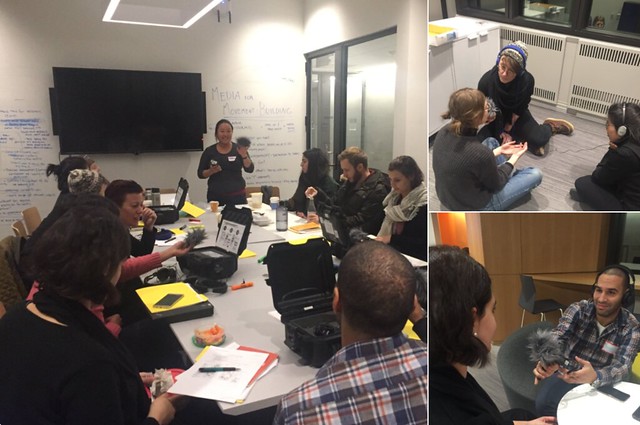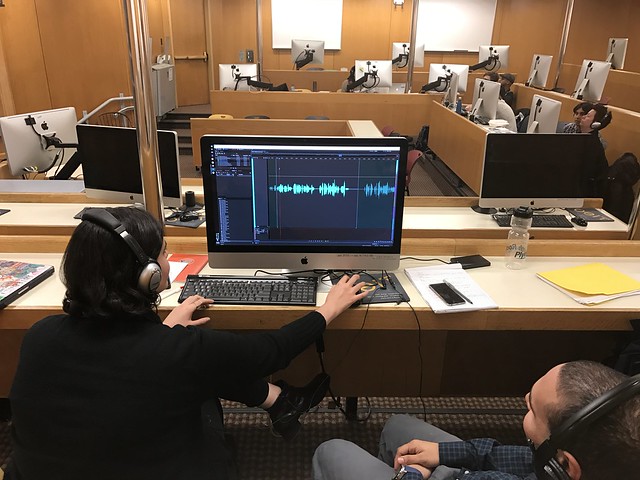This post was originally published over at MIT CoLab.
—-
One of the most fulfilling experiences I have had this year was that of planning, recording and editing my first podcast episode ever (along with my collaborators… more about them coming soon).
Now: as a technological capacity builder and media researcher, few things bring me as much joy as the powerful processes where tech, media-making and collaboration are all part of one learning experience. However, I am usually the facilitator; I rarely get to do the direct learning myself. I had forgotten what it feels like to learn like that.
It feels like the excitement of technological discovery in unpacking the audio recorder, caressing the windjammer and learning about waves and decibels. The awe when listening, more actively than ever, to others’ work and discovering the features I had always taken for granted. The creative flow of ideating interview arcs with my brilliant collaborators – Jordan Frias, journalist, and Lesly Monroy, ZUMIX youth musician.

Along the journey of technological discovery, I picked up a few tips that come in hand when recording and editing audio:
- Well, yes: use a proper recorder with mics properly dressed in fur.
- Hold the mic at a hand’s distance from people’s mouths and slightly off axis to avoid hearing their ”P”s pop in the recording.
- Check and adjust the sound levels before you actually record.
- If you’re the one speaking, use the full range of your voice, without forgetting the middle.
- Don’t forget to record room tone at the end!
- When it’s time to edit, put on your over-ear headphones (never trust your speakers).
- Also, don’t edit your raw audio; edit the copy.
And then there are the learnings that come from active listening. We were listening, yes, for instances that show proper executions of the recipe above; but also for the things that can make podcasts a part of movement-building since not every podcast is aligned with broader advocacy goals. It comes down to how we tell stories, how power gets assigned in these stories, whose voices are portrayed, and what these stories reflect about our relationships with their characters. Podcasting for movement building ultimately comes down to how we tell stories not on behalf of, but with, their characters. My takeaways:
- I found one of the Center for Story-based Strategy’s handouts very good for analyzing power dynamics in a narrative.
- Of all possible analogies to make sense of interviews, the one that poses them as a journey resonated with me the most: you don’t jump into a journey with anyone, so don’t expect someone else to do it with you. Build the relationship first.
- Honor your interviewee’s input: don’t forget to leave time for their reflections so they can talk about what you did not ask them.
- Whose voices? I loved reading this text on disabled voices in radio by Alice Wong, and this one on vocal color by Chenjerai Kumanyika. (I also loved discovering Transom, really.)
There are also the media-specific stylistic choices that are relevant not to all stories, but to those in podcast format in particular. The writing needs to be tight and clear, using simple tenses. People need to be reminded of the story constantly. Music and ambient sound are not luxuries: they are elements that carry the message forward. But don’t be too ambitious: podcast as a format could be, in fact, conducive to bite-sized explainerism.
All of this, of course, is much easier said than done. Like most of my production experiences at MIT, I feel that this course was as much an exercise in empathy as a workshop. After hours spent in East Boston to better understand the issues at stake, planning, interviewing, trying to gather ambient sound, building a conservative narrative that wouldn’t require too much editing, truth is we still spent an absurd and unsustainable amount of time putting it together.

Did we succeed in the end? In telling Luis Bravo’s story, which is decidedly worth telling, we learned about a miracle of Spanish-speaking community newspapers in Boston and we gave potential listeners ideas on what they can do going forward. But, like in all media-making, we have no evidence that anybody will ever listen to what we recorded.
This moment of painful humility, in a world of overworked and underpaid advocacy, could pose this work as a distraction from strategic action. However, having also felt the glory of listening to the final version after hours of obsessing over details and fiddling with editing software, of seeing Lesly’s smile after she heard her Spanish voice on the recording, my own vision of media for movement building has been strengthened.
The power of podcasting for movement building does not stem just from its products, but from its process. For a devout, I had forgotten what the learnings and disappointments and glories felt like. I am happy to have seen my faith and empathy for collaborative media-making processes be renewed, and already looking forward to many more of these processes, both facilitating and making-feeling.
———————
This post is a reflection on MIT CoLab’s Media for Movement Building IAP Course, which was held in collaboration with ZUMIX, to teach about audio collection as a method for place-based inquiry.
Mariel García-Montes is an activist on hold, and current graduate student in Comparative Media Studies at MIT. She is a research assistant at the Center for Civic Media, and an affiliate at the Berkman Klein Center for Internet and Society.
All photographs were taken by Lawrence Barriner II for MIT CoLab.
